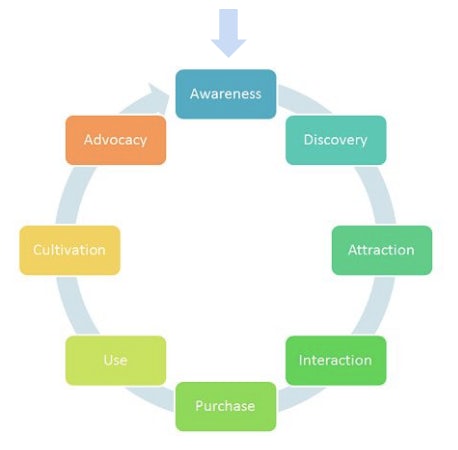Digital marketing today isn’t just about reach and coverage.
Of course, you know that already.
But what many marketers don’t know is how to use the range of reach and coverage focused techniques to generate real leads and sales for their business.
Being an agency means we’re working with a wide range of clients and industries to achieve different goals with different audiences. One thing’s consistent though; all of our clients want to make money out of what we’re doing.
So, I thought I’d share a few case studies from recent months to outline some of the ways we use marketing channels and techniques to generate tangible, measurable leads and sales.
Feeding the funnel
Much of what we do revolves around what I’d term ‘feeding the funnel’.
Sales is all about funnels and conversions, the idea being that we get people into a ‘journey’ with us that ideally leads to them buying from us – and staying with us thereafter.
Indeed, calling it a funnel is a little misleading; let’s think of it more like a cycle:

What we see here is a pretty standard customer lifecycle visualisation. The part I’m interested in right now is that arrow leading into awareness. When we can keep feeding people into this, we can then optimise each part of that journey to keep them in and keep upselling over time too.
So what’s this got to do with content, influencer marketing and PR?
For me, it’s all about recognising the value of those channels in delivering new people into that cycle.
Aiming for quality traffic
To feed the funnel, our tangible KPI is usually traffic. This traffic is usually (and ideally) targeted to a certain page on your site.
That might be a page intended to drive conversions. If so, you’re sending as much traffic as possible with a view to sending the quality of traffic most likely to convert, and therefore, you can measure conversion rate as your final goal.
Typically, campaigns are more complex than that. The idea that someone will enter the funnel and buy immediately is less and less common – especially as ‘shopping around’ is easier than ever.
When working with clients on setting goals, I refer to the traffic building stage as ‘phase 1’. It’s during this phase that we’re looking for volume and quality, knowing that that traffic is unlikely to convert right away.
That’s where influencer marketing, content marketing and digital PR come in. These aren’t about capturing people who are already searching for what you do. Instead, they’re about raising awareness amongst a brand new audience.
Influencer marketing
This is a discipline that’s fairly new to our toolkit. Essentially, the term is a simple reworking of what we’ve done for years though – it’s about knowing who influences your audience and engaging with them in a creative way.
Here are my tips for influencer marketing:
- Know who your influencers are from the start; tools like Buzzstream Discovery work really well for this and allow you to filter people by social following, DA, location and more
- Engage with influencers directly, by asking them to contribute their expertise or content; of course, you’ll need to give them a good reason to do so, so be ready to quote reach or authority stats to them about your own business. You’re not looking to pay for this
- Choose influencers who have a good social following and who will be willing to help you spread your content through their social channels
Content marketing
Content marketing feels a bit like the kid that was really cool last year at school, but since influencer marketing turned up with it’s new shoes and fashionable backpack, it’s been relegated.
The truth is that content marketing, having been the big buzz term of 2015, is still very much alive and kicking. As marketers, we’re finding more creative and more mature ways of using content to help us reach wider audiences and gain links to our websites. Check out my blog post over on Smart Insights which talks about how to come up with persona driven content marketing campaigns.
Here are my tips for content marketing:
- Choose a topic that is not so far removed from your product that it doesn’t make sense; use the ‘target’ approach I talk about on Smart Insights to identify related topics of interest, or use Google Analytics affinity categories to better understand key parts of your audience and what appeals to them
- Make sure your content hasn’t been made before; it needs to offer a new spin on an existing idea or a brand new idea altogether
- Make your content ‘credible’; if you’re not the credible source of the information – i.e. if you were creating a piece of content about broadband speeds and their affect on business but you’re not a broadband provider yourself – make sure you use a credible source (get the broadband data from a broadband provider) or add credibility to what you’re saying using expert commentary
- Know what the ‘headlines’ of your content are before you start; content marketing and PR work hand in hand, so identifying potential PR stories in your idea and crafting your content around that can be hugely beneficial
- Create content that reflects a brand value or core message for your business; the days of creating content just to ‘get links’ are long behind us
Digital PR
Digital PR is all about communicating messages effectively. That means it’s partly about talking about things that are happening in your business already – new hires, awards and so on. But that’s not where the fun lies for me.
The ‘fun’ and the real traffic potential comes when you can generate your own PR stories.
This could be as ‘straightforward’ as running a survey (though ‘straightforward’ still means crafting questions with a clear PR angle in mind, finding the right respondents, having a plan to get those responses and so on). It could be more complex, such as an offline PR ‘stunt’ or the analysis of data that already exists in the public domain to pull out new angles and interest.
Digital PR is one area that, in my opinion, has suffered in the past from a lack of focus on tangible metrics. Yes, ‘features’ are important (and I’m a big advocate of the ‘implied link’), but so too are tangible KPIs such as DA improvement, traffic generation and attributed goals.
Here are my tips for digital PR:
- Spend as little time as possible promoting general business stories; local press will likely cover your new hire even if all you send them is a quick press release or email
- Focus more of your time on how you can generate news stories in a way that makes sense for your business and helps you communicate your messages effectively
- Know who your target publications are and what journalists are looking for before you start. Do your research to see what’s been covered and use tools like Response Source and Gorkana to understand trends in what journalists typically seek throughout the year
- Make your content credible using credible data sources or supplementing with expert commentary
A phased approach to creative campaigns
A ‘campaign’ is a marketing project that uses a number of different channels to achieve its goals.
Creating an infographic is not a campaign.
Writing a report is not a campaign.
Instead, a campaign must have clear stages and goals at each stage, the idea being that you take audiences through a journey leading to conversions.
I typically take a phased approach to creative campaigns.
Phase 1 is what I talked about above; it’s about generating a high quality of traffic with characteristics that match your offering or your existing client base.
The next phase is usually structured around remarketing and follow up offers. That’s where we start thinking about tangible conversions – which could be sales, could be enquiries, could be downloads and information gathering.
Using Google Analytics, for example, we can create audiences of people who have viewed the traffic-building content you produced (providing it’s hosted on your site). We can then create remarketing campaigns using AdWords to target those audiences with offers.
We can use lead capture techniques to gather people’s email addresses, and use those in email marketing, targeted social advertising and the building of lookalike audiences, to which we can send targeted offers designed to move people to the next stage of the customer journey.
Phase 3 is all about improving conversion rates through conversion rate optimisation techniques. This can be done on-site, looking at how the conversions are encouraged and captured, or off site, for example testing different audiences for social ads.
Structuring a successful creative campaign
With all of this in mind, there are a few basic requirements of a successful creative campaign:
- Create content through content marketing, influencer marketing and PR that’s intended to drive high quality traffic
- Back your content with a paid advertising budget to push it to the next level and split test audiences
- Send audience members to a targeted page or section of your website, that allows you to build a remarketing list or capture user information
- Have a clear follow up offer that is very conversion-centric
We’d love to talk to you about your next marketing campaign. Get in touch today! You can also drop me a comment in the comments box below; I’d love to get your feedback.



